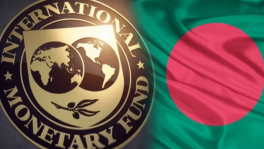Protection vs Productivity – the future of the private sector in Bangladesh

Bangladesh aspires to be an upper-middle income country within a decade and a high-income country within two decades. Such ambition is good. But we must remember that many other countries with similar ambitions have failed to make the graduation.
Many lower middle-income countries have failed to become upper middle-income, and many middle-income countries have failed to become high-income. They have fallen in what is called the middle-income trap.
Consider the following graph which shows the long-run trend in real GDP for three countries, Argentina, South Africa and South Korea. In 1960, Argentina had the largest economy of the three followed by South Africa and South Korea. Till the mid-1980s, the countries were not far off in terms of their real GDP size. But then the scenario changed dramatically. In the next three and a half decades, the Argentinian economy grew at a modest pace and South Africa at an even slower pace. By contrast, South
Korea took off in a big way. In 1960, it had the smallest economy of the three. Now, its economy is double that of Argentina and South Africa combined.
Argentina and South Africa had fallen in the middle-income trap while South Korea has avoided it to become a high-income country. There are other examples also of countries being caught in this trap. Thus, there is no guarantee that even if Bangladesh achieves middle-income status within a decade or so – and that, by no means, is guaranteed – it may not necessarily graduate to become a high-income country. Let us be ambitious but not complacent. Let us learn what differentiates the South Koreas of the world from the Argentinas and the South Africas of the world.
In their recent book The Power of Creative Destruction, the noted French economist Philippe Aghion and his co-authors Celine Antonin and Simon Bunel devote a chapter to the middle-income trap. There they contrast the cases of Argentina and South
Korea. They argue that Argentina fell into the middle-income trap because it remained an agricultural economy based on capital accumulation and did not make the required transformation to an industrial economy based on innovation. They write:
"Argentina should have diversified its production, industrialized to a greater extent, and invested in innovation. Instead, it withdrew within its borders and adopted a policy of import substitution rather than developing its exports and confronting international competition."
But why didn't Argentina innovate on the scale required? Aghion and his co-authors suggest: "The explanation is that frontier innovation policies may go against the interests of the incumbents. Accordingly, they will use some of their accumulated wealth to pressure politicians and judges to prevent the introduction and implementation of new, pro-competitive rules." Sound familiar?
So, what happened in South Korea then? South Korea's development efforts from the 1960s to the late 1990s relied heavily on large industrial and financial conglomerates, the so-called chaebols. These chaebols enjoyed a wide array of support from the government - from tariff protection to export subsidies, from preferential credit to restrictions on entry of new firms that could compete with them. The chaebols grew a lot, thanks to such privileges. By the early 1990s, the five largest chaebols, Hyundai,
Samsung, Daewoo, LG, and the SK Group accounted for 10 per cent of Korea's GDP. These companies became behemoths, but their huge size masked any inefficiencies and vulnerabilities.

These weaknesses came to the surface when the financial crisis hit in 1997 and 1998. Some chaebols, such as Daewoo, got bankrupt; others were substantially weakened. The government moved away from its earlier policy stance and went for more pro-competition policies. This resulted in the entry of many new, innovative firms. Aghion and co-authors provide a revealing set of statistics. They write: "At the beginning of the 1990s South Korea filed eight times fewer patent applications with the US
Patent and Trademark Office than did Germany. In 2012 it filed 30% more applications than Germany despite having only half the population." Clearly Korean firms had become more innovative. Productivity, which was stagnating or dropping before the crisis, started rising fast after 1998.
The contrasting stories of Argentina and South Korea are instructive for Bangladesh. The lessons are clear. We need a private sector that is driven by innovation, with a continuous hunger for productivity improvement. We need investment, but we need innovation too.
And we need investment not just in expanding capacity but in improved products, more efficient processes, and agile business models. For this to happen, we need the right incentives in place. If the private sector has the incentive to increase productivity, it will find a way to do so. If they are constrained for some reason, government may consider taking action to remove the constraints. But the incentives need to be strong for investing in productivity improvements.
If the private sector knows that it can make a lot of money through political connections that give it privileges, it will invest in developing such connections rather than on productivity enhancing capabilities. If enterprises are protected by high tariff barriers, as is the case with electronics industry for instance, there is a risk that firms may get used to the easy life and not worry about productivity improvements.
The same is true if industries, as is the case with garments, are given cash subsidies every time they face some difficulty. This way, inefficient firms will be propped up and any required restructuring in the industry will not happen.
It is argued that firms sometimes need such support because it provides a cushion to help move up the learning curve. There is some merit in that argument but in such cases the protection needs to be time-bound and made contingent on learning and productivity improvements.
That is why the time has come to take a hard look at the nature of our current policy regime through the lens of productivity and innovation. Is the policy regime conducive to innovations and productivity improvements or is it giving the wrong signals? Is it promoting competition so that inefficient firms are weeded out or providing privileges and protection that perpetuates inefficiency? If Bangladesh truly aspires to an upper middle-income status and eventually a high-income status, it must be aware that many countries have not made such a graduation. So, we can not take this for granted. It is important to bring competition, productivity, and innovation to the center stage.
The policy regime should be such that it promotes investment in competitiveness not in connections. It should be such that it promotes productivity, not protection. It should be such that it favors innovators, not the ossified incumbents.


 Keep updated, follow The Business Standard's Google news channel
Keep updated, follow The Business Standard's Google news channel














